radiator TOYOTA CAMRY 2011 XV50 / 9.G Owners Manual
[x] Cancel search | Manufacturer: TOYOTA, Model Year: 2011, Model line: CAMRY, Model: TOYOTA CAMRY 2011 XV50 / 9.GPages: 554, PDF Size: 9.69 MB
Page 362 of 554
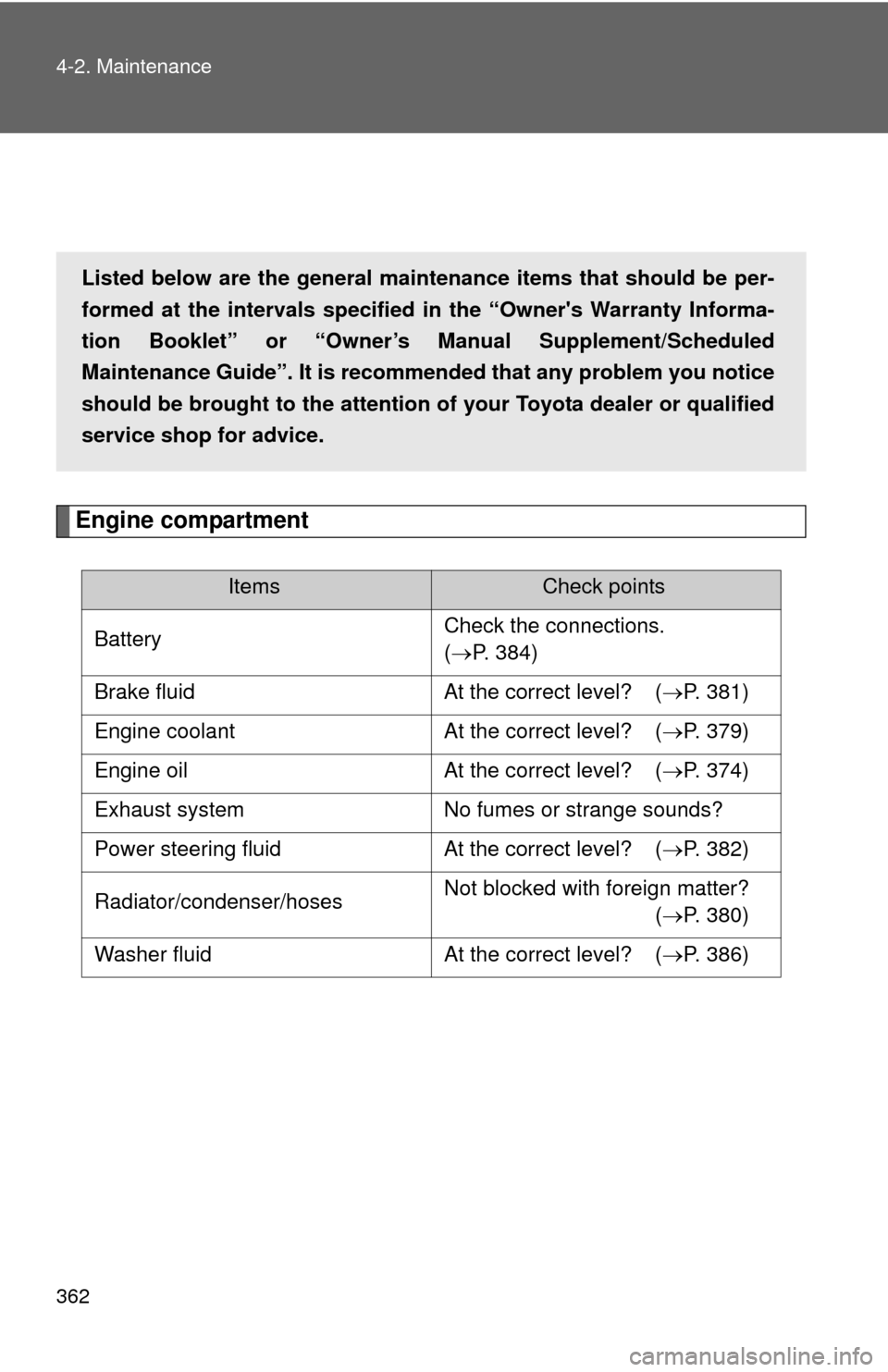
362 4-2. Maintenance
General maintenance
Engine compartment
ItemsCheck points
Battery Check the connections.
(
P. 384)
Brake fluid At the correct level? ( P. 381)
Engine coolant At the correct level? ( P. 379)
Engine oil At the correct level? ( P. 374)
Exhaust system No fumes or strange sounds?
Power steering fluid At the correct level? ( P. 382)
Radiator/condenser/hoses Not blocked with foreign matter?
(
P. 380)
Washer fluid At the correct level? ( P. 386)
Listed below are the general maintenance items that should be per-
formed at the intervals specified in the “Owner's Warranty Informa-
tion Booklet” or “Owner’s Manual Supplement/Scheduled
Maintenance Guide”. It is recommended that any problem you notice
should be brought to the attention of your Toyota dealer or qualified
service shop for advice.
Page 367 of 554
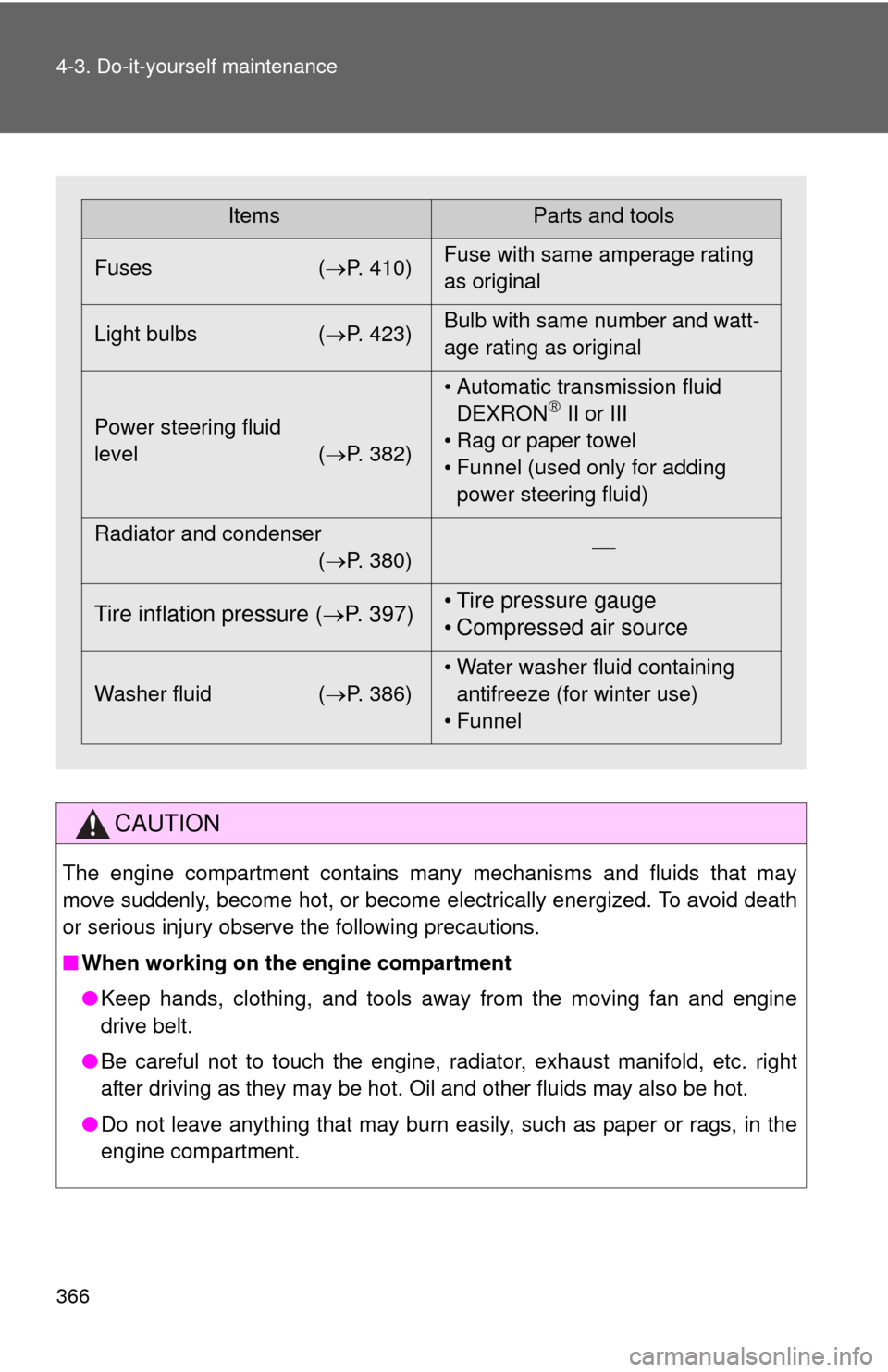
366 4-3. Do-it-yourself maintenance
CAUTION
The engine compartment contains many mechanisms and fluids that may
move suddenly, become hot, or become electrically energized. To avoid death
or serious injury observe the following precautions.
■When working on the engine compartment
●Keep hands, clothing, and tools away from the moving fan and engine
drive belt.
● Be careful not to touch the engine, radiator, exhaust manifold, etc. right
after driving as they may be hot. Oil and other fluids may also be hot.
● Do not leave anything that may burn easily, such as paper or rags, in the
engine compartment.
ItemsParts and tools
Fuses ( P. 410)Fuse with same amperage rating
as original
Light bulbs ( P. 423)Bulb with same number and watt-
age rating as original
Power steering fluid
level ( P. 382)• Automatic transmission fluid
DEXRON
II or III
• Rag or paper towel
• Funnel (used only for adding power steering fluid)
Radiator and condenser (P. 380)
Tire inflation pressure (
P. 397) • Tire pressure gauge
• Compressed air source
Washer fluid
(P. 386) • Water washer fluid containing
antifreeze (for winter use)
• Funnel
Page 368 of 554
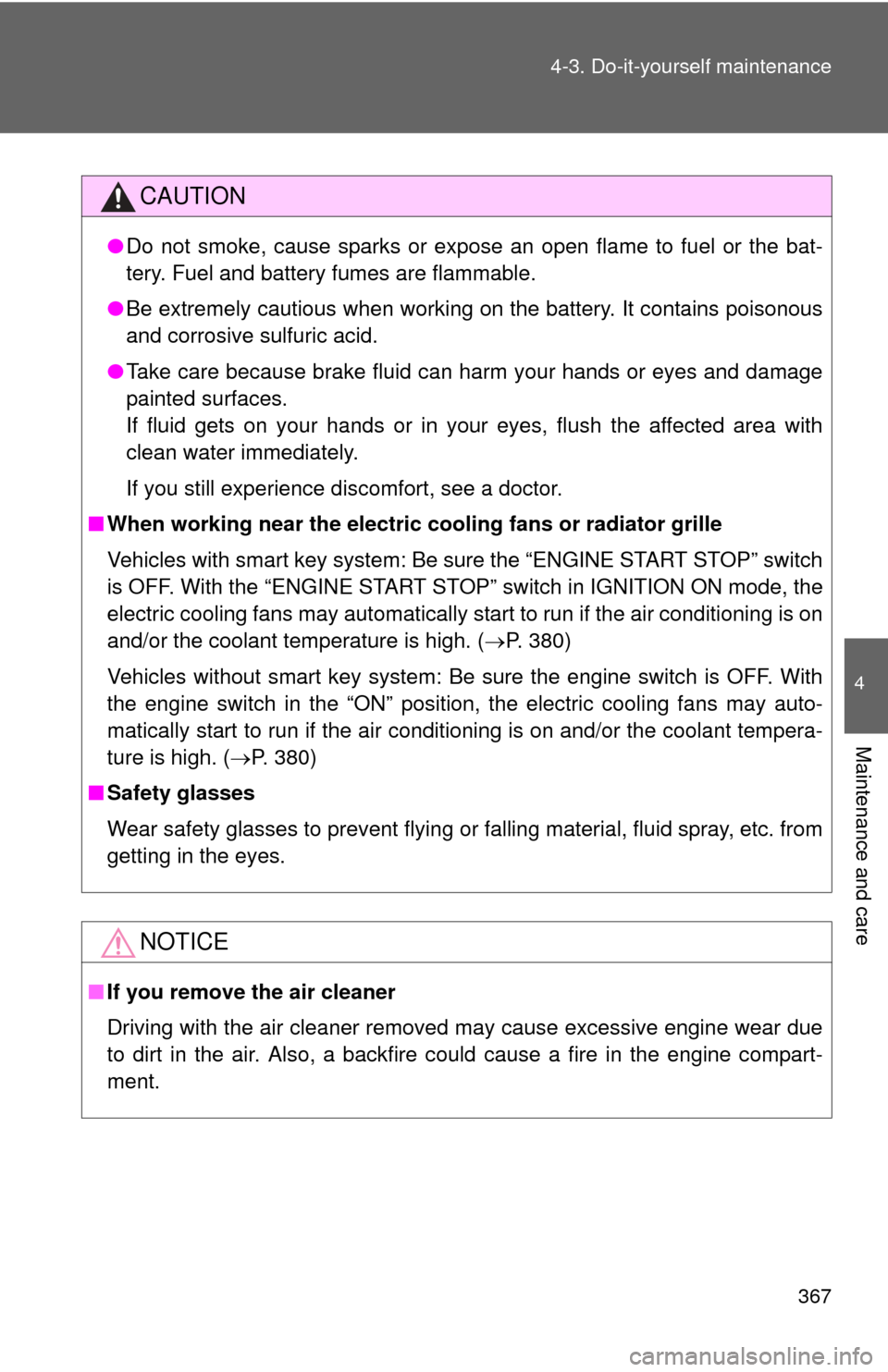
367
4-3. Do-it-yourself maintenance
4
Maintenance and care
CAUTION
●
Do not smoke, cause sparks or expose an open flame to fuel or the bat-
tery. Fuel and battery fumes are flammable.
● Be extremely cautious when working on the battery. It contains poisonous
and corrosive sulfuric acid.
● Take care because brake fluid can harm your hands or eyes and damage
painted surfaces.
If fluid gets on your hands or in your eyes, flush the affected area with
clean water immediately.
If you still experience discomfort, see a doctor.
■ When working near the electric c ooling fans or radiator grille
Vehicles with smart key system: Be sure the “ENGINE START STOP” switch
is OFF. With the “ENGINE START STOP” switch in IGNITION ON mode, the
electric cooling fans may automatically start to run if the air conditioning is on
and/or the coolant temperature is high. ( P. 380)
Vehicles without smart key system: Be sure the engine switch is OFF. With
the engine switch in the “ON” position, the electric cooling fans may auto-
matically start to run if the air conditioning is on and/or the coolant tempera-
ture is high. ( P. 380)
■ Safety glasses
Wear safety glasses to prevent flying or falling material, fluid spray, etc. from
getting in the eyes.
NOTICE
■If you remove the air cleaner
Driving with the air cleaner removed may cause excessive engine wear due
to dirt in the air. Also, a backfire could cause a fire in the engine compart-
ment.
Page 372 of 554
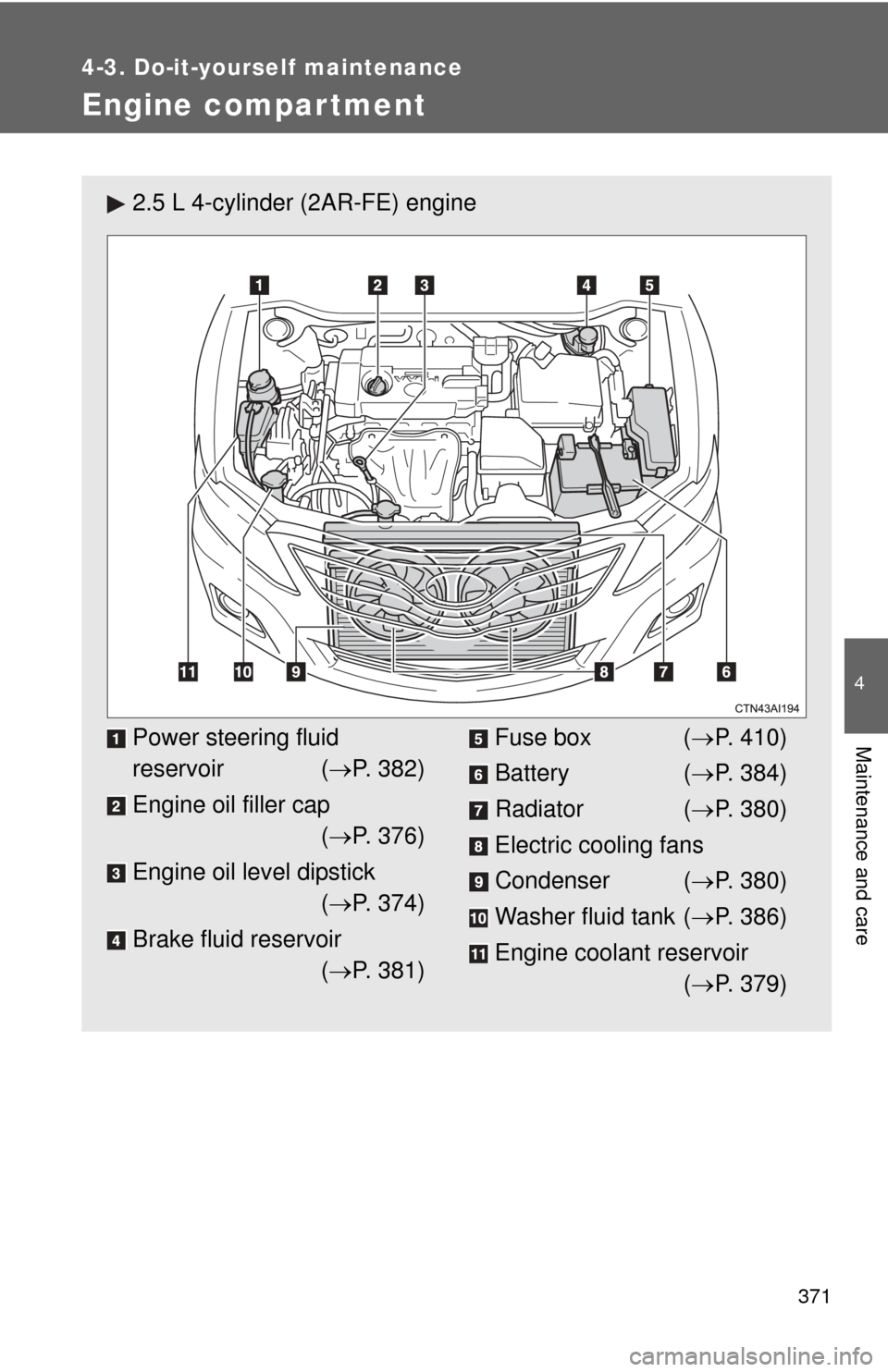
371
4-3. Do-it-yourself maintenance
4
Maintenance and care
Engine compar tment
2.5 L 4-cylinder (2AR-FE) engine
Power steering fluid
reservoir (P. 382)
Engine oil filler cap ( P. 376)
Engine oil level dipstick ( P. 374)
Brake fluid reservoir ( P. 381)Fuse box ( P. 410)
Battery ( P. 384)
Radiator ( P. 380)
Electric cooling fans
Condenser ( P. 380)
Washer fluid tank ( P. 386)
Engine coolant reservoir ( P. 379)
Page 373 of 554
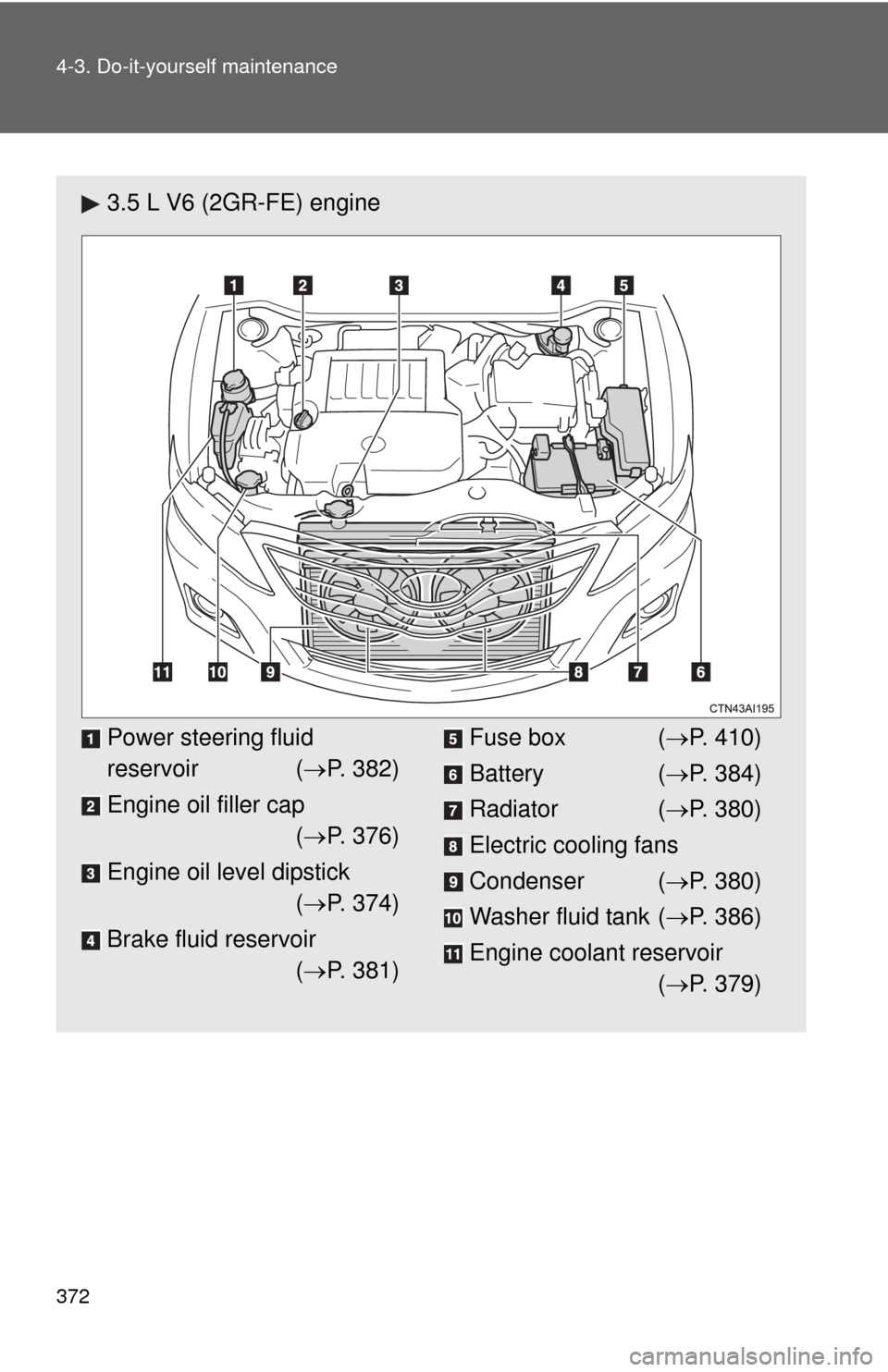
372 4-3. Do-it-yourself maintenance
3.5 L V6 (2GR-FE) engine
Power steering fluid
reservoir (P. 382)
Engine oil filler cap ( P. 376)
Engine oil level dipstick ( P. 374)
Brake fluid reservoir ( P. 381)Fuse box ( P. 410)
Battery ( P. 384)
Radiator ( P. 380)
Electric cooling fans
Condenser ( P. 380)
Washer fluid tank ( P. 386)
Engine coolant reservoir ( P. 379)
Page 380 of 554
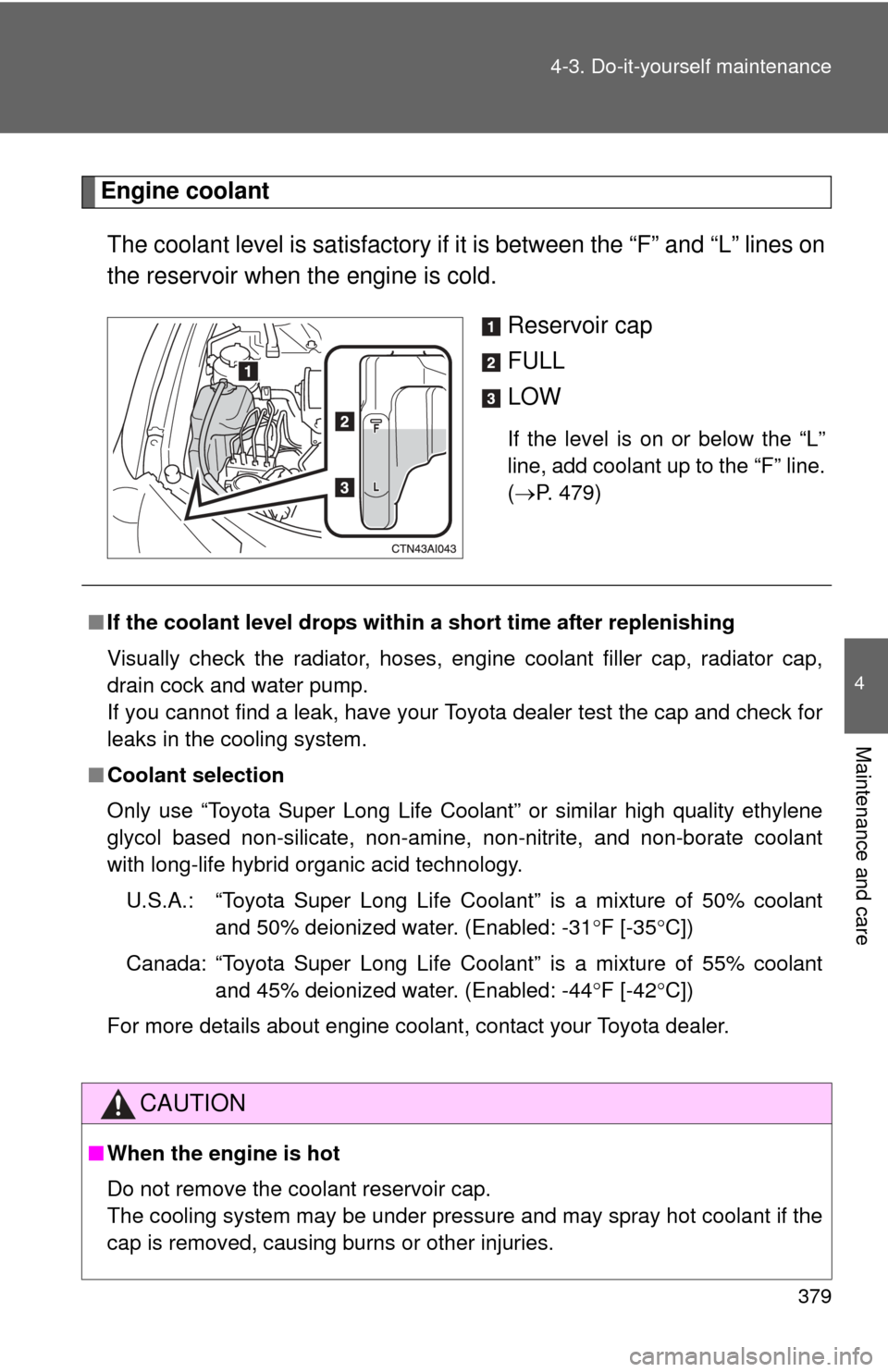
379
4-3. Do-it-yourself maintenance
4
Maintenance and care
Engine coolant
The coolant level is sati sfactory if it is between the “F” and “L” lines on
the reservoir when the engine is cold.
Reservoir cap
FULL
LOW
If the level is on or below the “L”
line, add coolant up to the “F” line.
(P. 479)
■ If the coolant level drops within a short time after replenishing
Visually check the radiator, hoses, engine coolant filler cap, radiator cap,
drain cock and water pump.
If you cannot find a leak, have your Toyota dealer test the cap and check for
leaks in the cooling system.
■ Coolant selection
Only use “Toyota Super Long Life Coolant” or similar high quality ethylene
glycol based non-silicate, non-amine, non-nitrite, and non-borate coolant
with long-life hybrid organic acid technology.
U.S.A.: “Toyota Super Long Life Coolant” is a mixture of 50% coolant and 50% deionized water. (Enabled: -31 F [-35 C])
Canada: “Toyota Super Long Life Coolant” is a mixture of 55% coolant and 45% deionized water. (Enabled: -44 F [-42 C])
For more details about engine coolant, contact your Toyota dealer.
CAUTION
■ When the engine is hot
Do not remove the coolant reservoir cap.
The cooling system may be under pressure and may spray hot coolant if the
cap is removed, causing burns or other injuries.
Page 381 of 554
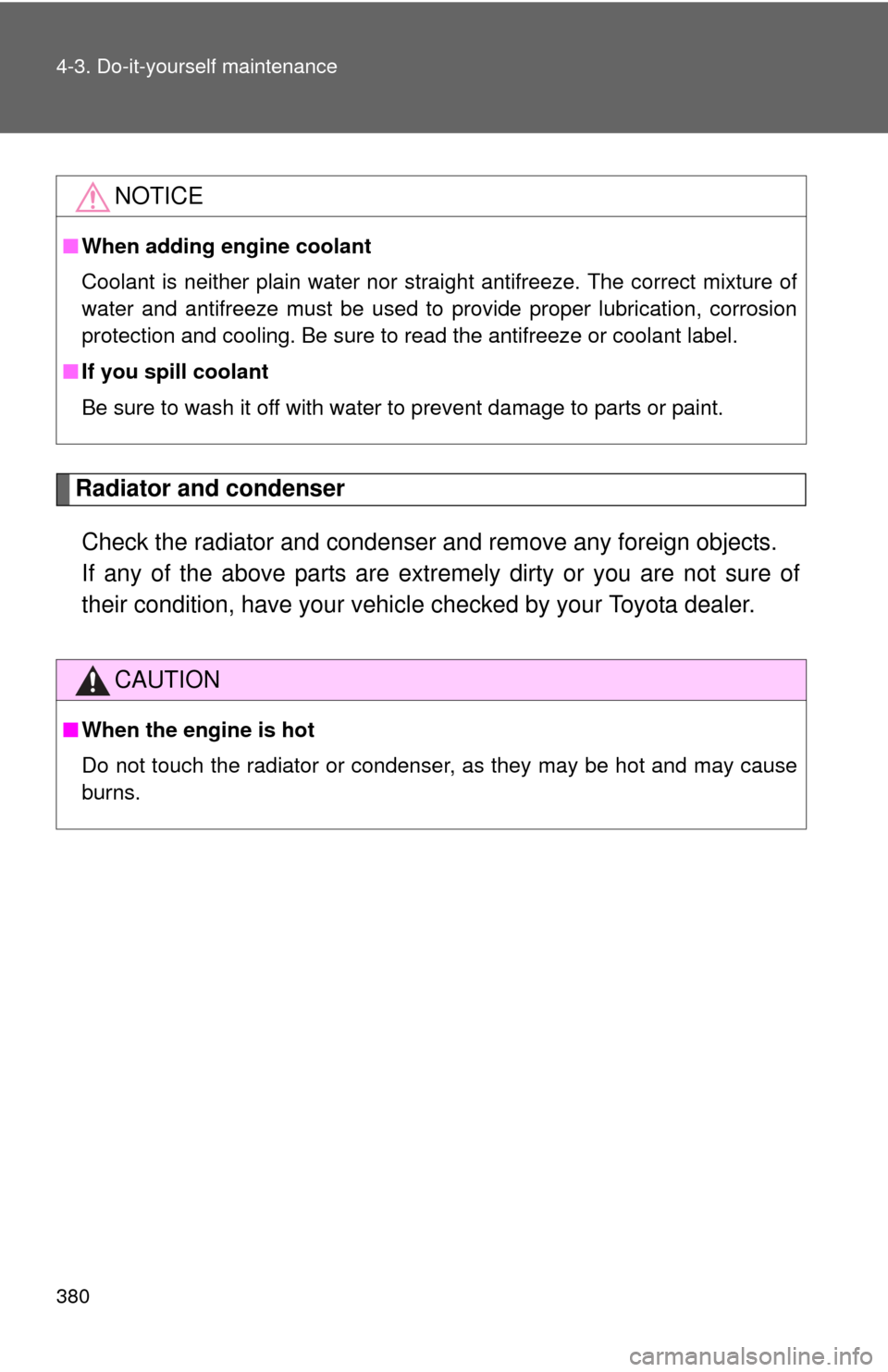
380 4-3. Do-it-yourself maintenance
Radiator and condenserCheck the radiator and condenser and remove any foreign objects.
If any of the above parts are extr emely dirty or you are not sure of
their condition, have your vehicl e checked by your Toyota dealer.
NOTICE
■When adding engine coolant
Coolant is neither plain water nor stra ight antifreeze. The correct mixture of
water and antifreeze must be used to provide proper lubrication, corrosion
protection and cooling. Be sure to read the antifreeze or coolant label.
■ If you spill coolant
Be sure to wash it off with water to prevent damage to parts or paint.
CAUTION
■When the engine is hot
Do not touch the radiator or condenser, as they may be hot and may cause
burns.
Page 481 of 554
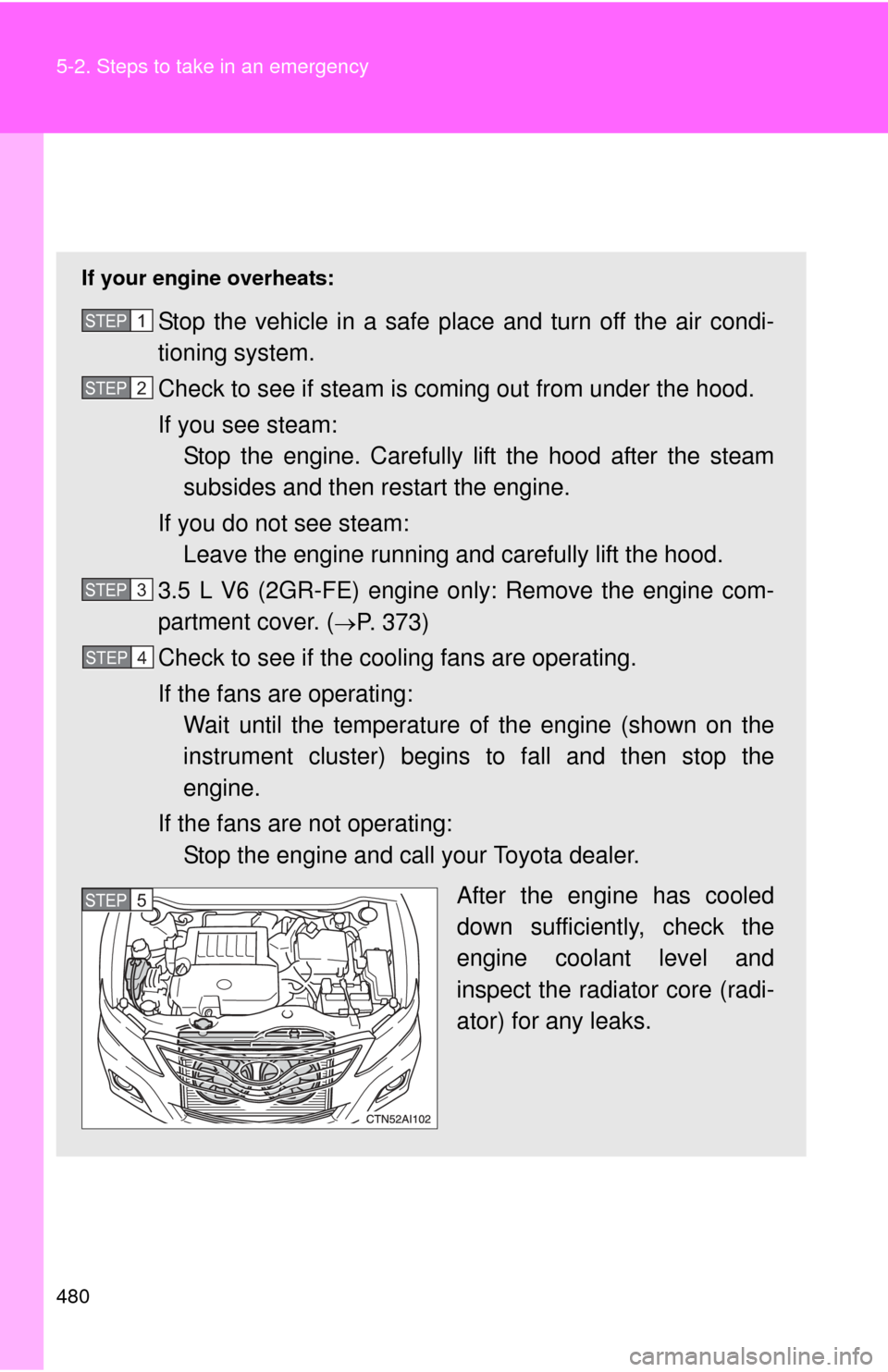
480 5-2. Steps to take in an emergency
If your vehicle overheats
If your engine overheats:
Stop the vehicle in a safe place and turn off the air condi-
tioning system.
Check to see if steam is coming out from under the hood.
If you see steam: Stop the engine. Carefully lift the hood after the steam
subsides and then restart the engine.
If you do not see steam: Leave the engine running and carefully lift the hood.
3.5 L V6 (2GR-FE) engine only: Remove the engine com-
partment cover. (
P. 373)
Check to see if the cooling fans are operating.
If the fans are operating: Wait until the temperature of the engine (shown on the
instrument cluster) begins to fall and then stop the
engine.
If the fans are not operating: Stop the engine and call your Toyota dealer.
After the engine has cooled
down sufficiently, check the
engine coolant level and
inspect the radiator core (radi-
ator) for any leaks.
STEP1
STEP2
STEP3
STEP4
STEP5STEP5
Page 482 of 554
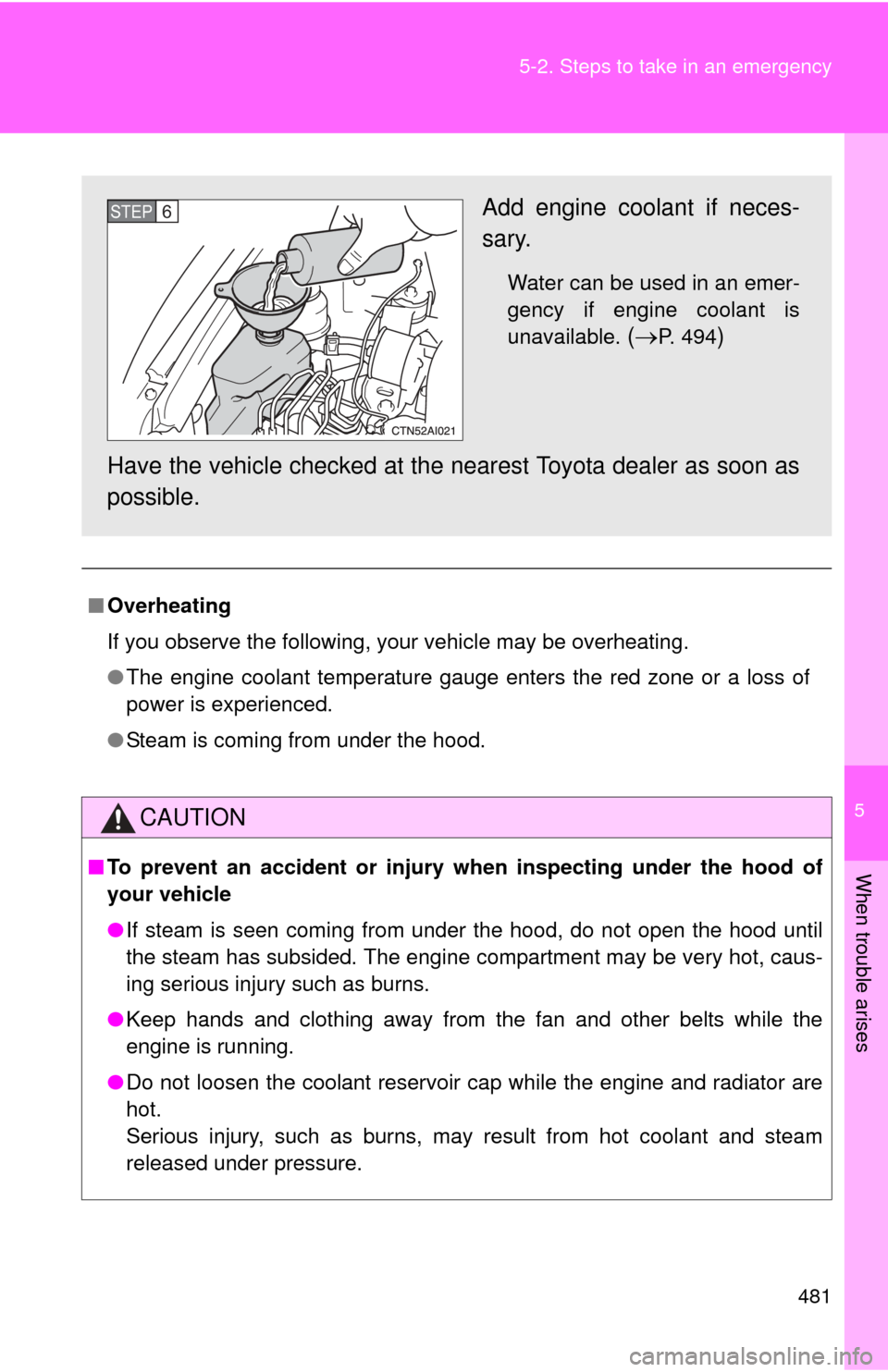
5
When trouble arises
481
5-2. Steps to take in an emergency
■
Overheating
If you observe the following, your vehicle may be overheating.
●The engine coolant temperature gauge enters the red zone or a loss of
power is experienced.
● Steam is coming from under the hood.
CAUTION
■To prevent an accident or injury when inspecting under the hood of
your vehicle
●If steam is seen coming from under the hood, do not open the hood until
the steam has subsided. The engine compartment may be very hot, caus-
ing serious injury such as burns.
● Keep hands and clothing away from the fan and other belts while the
engine is running.
● Do not loosen the coolant reservoir cap while the engine and radiator are
hot.
Serious injury, such as burns, may result from hot coolant and steam
released under pressure.
Add engine coolant if neces-
sary.
Water can be used in an emer-
gency if engine coolant is
unavailable.
(P. 494)
Have the vehicle chec ked at the nearest Toyota dealer as soon as
possible.
STEP6
Page 547 of 554

545
Alphabetical index
Odometer ......................... 150, 158
Oil
Engine oil.............................. 374
Opener Fuel filler door......................... 79
Hood ..................................... 368
Trunk ...................................... 49
Outside rear view mirrors
Adjusting and folding .............. 70
Outside temperature display ........................... 150, 158
Overheating, Engine ............... 479
Parking brake .......................... 147
Parking lights Switch ................................... 162
Wattage ................................ 500
Personal lights Switch ................................... 320
Wattage ................................ 500
Power outlet............................. 333
Power steering fluid ................ 382
Power windows ......................... 72 Radiator ....................................380
Radio .........................................220
Rear side marker lights
Replacing light bulb ...............423
Switch....................................162
Rear seats Adjustment ..............................55
Folding down ...........................56
Rear sunshade .........................338
Rear turn signal lights Replacing light bulbs .............423
Wattage .................................500
Rear view mirror Compass ...............................349
Rear window defogger ............214
Replacing Fuses ....................................410
Key battery ............................406
Light bulbs .............................423
Tires ......................................458
Reporting safety defects for U.S.A. owners ........................522O
P
R